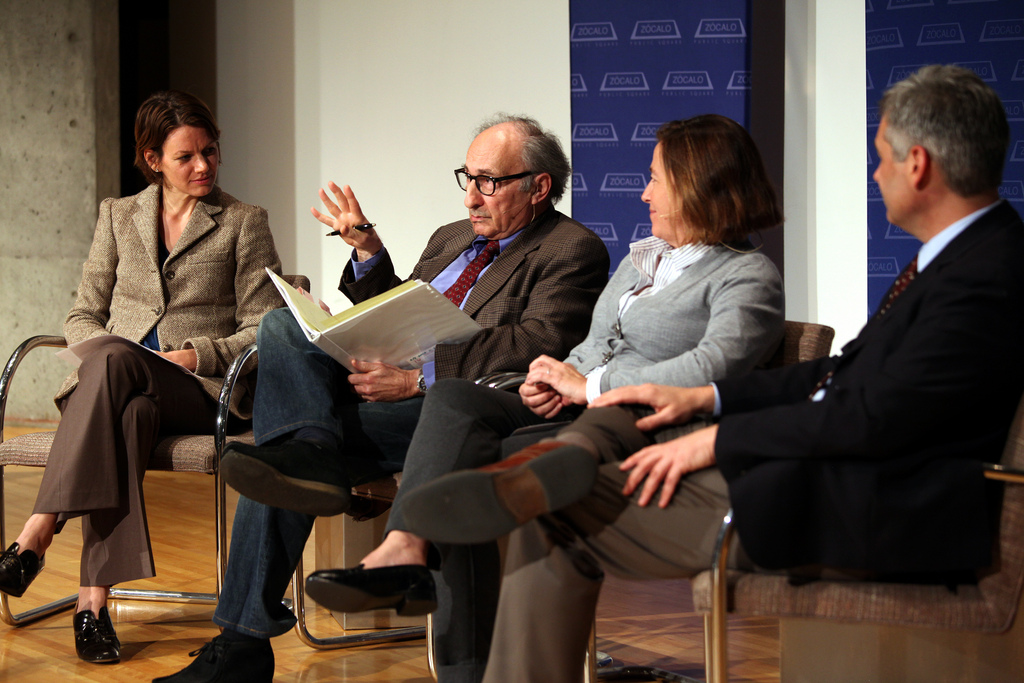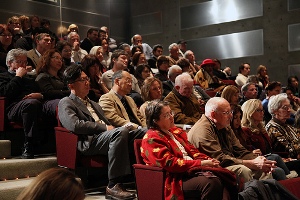
From edible pills that keep watch over vitals to heart monitors that text message doctors, medical technology can start to seem a little like science fiction.
“Much of this can seem like a future that is very far away, but I think many of us would be surprised to know that this future is already here,” said KQED health reporter Sarah Varney to the full house at MOCA Grand Avenue.
In an event generously sponsored by the California HealthCare Foundation, Varney joined Proteus Biomedical’s Greg Moon, USC bioethicist Michael Shapiro, and Leslie Saxon of the USC Center for Body Computing to explore what the vanguard of medical technology looks like, what it costs, and whether it puts us at risk.
Like macaroni and cheese
 Saxon, who specializes in treating life-threatening heart rhythms, often works with implantable defibrillators that can treat congestive heart failure – the number one reason Medicare patients are hospitalized. While Saxon has been implanting the devices for 20 years, in the last four years, they have been able to wirelessly delivered her data about her patients, often in conjunction with other devices, like a scale or blood-pressure monitor. The data can be summarized daily or provided on cue if vital signs change, and doctors can access it anywhere, anytime. “I can look at it at home on New Year’s Eve, as I did last year,” Saxon said.
Saxon, who specializes in treating life-threatening heart rhythms, often works with implantable defibrillators that can treat congestive heart failure – the number one reason Medicare patients are hospitalized. While Saxon has been implanting the devices for 20 years, in the last four years, they have been able to wirelessly delivered her data about her patients, often in conjunction with other devices, like a scale or blood-pressure monitor. The data can be summarized daily or provided on cue if vital signs change, and doctors can access it anywhere, anytime. “I can look at it at home on New Year’s Eve, as I did last year,” Saxon said.
Saxon can respond more quickly to problems by, for instance, sharing information with a patient’s primary care doctor or his family, and creating an engaged care team that includes the patient. “We need to connect everybody better,” she said. “We’re really trying – I hate to say empower because it’s nauseating – but working with the patients… Medical technology is like macaroni and cheese. It’s down-home and intimate.”
As Varney noted, heart failure affects five million Americans each year. “If I were a smart business person, I’d invest in this.”
Out of the black box
 The technology that Moon works with are further in the future, three years from the market – a daily pill that networks with cell phones to gather information about what medicines a patient takes, when it’s taken, and what the dosage is, all gathered in the context of other physical information like heart rates. The pill will collect the information and gives it back to the doctor and to the patient, who can decide who else sees it, including family members. Thus far, his company has produced six studies on the pill, including its impact on patients dealing with hypertension, heart failure, and mental health problems.
The technology that Moon works with are further in the future, three years from the market – a daily pill that networks with cell phones to gather information about what medicines a patient takes, when it’s taken, and what the dosage is, all gathered in the context of other physical information like heart rates. The pill will collect the information and gives it back to the doctor and to the patient, who can decide who else sees it, including family members. Thus far, his company has produced six studies on the pill, including its impact on patients dealing with hypertension, heart failure, and mental health problems.
It’s a particularly important technology given, Moon said, that many estimates show 50 percent of patients don’t take their medicine effectively. As he noted, generally, a patient visiting a doctor isn’t likely to say they haven’t properly taken medicine. “You’re left with this black box. Is the problem because the medicine is inefficient? Or it’s the wrong dosage? Or are people not taking it?” he said. “You want to do something, so you end up adjusting the meds.” His pill could provide the missing information not only for doctors, but for scientists conducting clinical trials, where
proper medicine intake is crucial to producing correct data.
The primary challenge for the pill is how much data it should produce. “Nobody, including the patients, want to get overloaded with information,” Moon said. “Walking through an ICU you hear all the alarms going off – most of the time, someone’s reaching over thoughtlessly and turning it off rather than looking at what’s causing it.” Moon aims to distill information for patients, who can decide how much information they want, from a thumbs-up to a full data chart.
The result, Saxon and Moon agreed, is a more engaged patient who can manage their care alone, as diabetics do with blood sugar monitors. “It’s amazing how quickly people learn themselves,” Saxon said. “My relationship with my wired patients is a much richer experience….That’s why I’m so motivated by it, that’s why I’m so evangelical about it.”
Privacy, regulation, and marketing
 Pills and monitors are “extremely promising,” Shapiro said. But, he added, “I do operate on Murphy’s Law…. My view is people are no damn good. Things are going to go wrong no matter what.” Shapiro noted that there is no privacy violation as long as patients agree to share their data, though forcing a patient to know what he doesn’t want to know could be problematic. As of now, Saxon said, her patients don’t automatically get the data their devices collect – only healthcare providers can see it, and they can be in touch with patients. “My bank can’t keep my financial information from me,” Saxon said. “Patients will say, ‘I want this information,’ and you have to give it to them, or else Google’s going to give it to them with a personal health record.”
Pills and monitors are “extremely promising,” Shapiro said. But, he added, “I do operate on Murphy’s Law…. My view is people are no damn good. Things are going to go wrong no matter what.” Shapiro noted that there is no privacy violation as long as patients agree to share their data, though forcing a patient to know what he doesn’t want to know could be problematic. As of now, Saxon said, her patients don’t automatically get the data their devices collect – only healthcare providers can see it, and they can be in touch with patients. “My bank can’t keep my financial information from me,” Saxon said. “Patients will say, ‘I want this information,’ and you have to give it to them, or else Google’s going to give it to them with a personal health record.”
The panelists also weren’t worried about the direct marketing of such devices to the patient, despite Varney’s point that direct marketing hasn’t always played out well with pharmaceuticals. Moon noted that the “consumerization movement” could make for better care and more engagement, as it has in the world of personal finance. And as Shapiro said, rather than complain about direct consumer marketing, physicians should be willing to talk to patients and answer their questions about devices. “If physicians cannot stand explaining things to patients, they’re in the wrong business,” Shapiro said, noting that he once had to explain to his doctor that the safe level for lead had been lowered. “He thanked me. He didn’t know.”
A potential problem could arise if compliance with monitoring devices is forced. “The worst case is if the physician said, ‘I’m not going to treat you unless you comply. That’s an abuse of medical monopoly,” Shapiro said. On the other hand, he noted, requiring monitoring from a recovering addict could be considered acceptable, along with required monitoring for recipients of transplanted organs.
Regulating these devices could create some difficulties for agencies like the Food and Drug Administration, Saxon said, because it challenges their model. “Is it different from electronic medical records, that they don’t regulate? Or is it airspace?” she said. “They find themselves needing to talk to the FCC.” But the agency does respond quickly if they see cost savings, Saxon said, or if consumers demand a particular product, as they did for HIV drugs.
Cost and dropped calls
 Saxon and Moon noted during Q&A that these devices could ultimately decrease healthcare costs. Saxon pointed out that better healthcare could come to the developing world through cell phones. And Moon added that large, integrated healthcare systems see the devices as potential cost savers that could decrease the number of doctor and hospital visits.
Saxon and Moon noted during Q&A that these devices could ultimately decrease healthcare costs. Saxon pointed out that better healthcare could come to the developing world through cell phones. And Moon added that large, integrated healthcare systems see the devices as potential cost savers that could decrease the number of doctor and hospital visits.
But as Saxon noted, “If people die, it’s not very expensive. But if they live, they live to enjoy some other disease that costs money.” Shapiro agreed: “We can pay for everything we want in the field of healthcare if we don’t pay for other stuff. The roads will crumble. We can stop paying for national defense.”
The audience also asked about device use and malfunction, whether data could be dropped as easily as cell phone calls. As Shapiro explained, “There is a field called product vulnerability. Devices go bad. Bridges fall down. Planes crash. There is that risk.” The risk could mean less investment in research and development of the devices, he said, as it had in vaccines and antibiotics. Missed information could create liability as well. “If I get data daily and I don’t look at it, what’s my liability?” Saxon said. “I often wonder what’s your liability if you have the capability and you don’t wire your patient?”
If the devices work and are affordable and everyone gets wired, a new challenge could arise. “Not everybody wants to be connected,” Shapiro said. And, as one audience member suggested, insurance companies might suggest a tiered system, in which those who pay less for a device give up more privacy. “What if patients aren’t selling their organs, but they’re selling their data?” Varney said. “That’s the next panel, I guess.”
Watch the video here.
See more photos here.
Read an online roundtable asking what technology will most revolutionize medicine here.
Read In The Green Room Q&As with Sarah Varney, Michael Shapiro, Leslie Saxon and Greg Moon.
*Photos by Aaron Salcido.




Send A Letter To the Editors